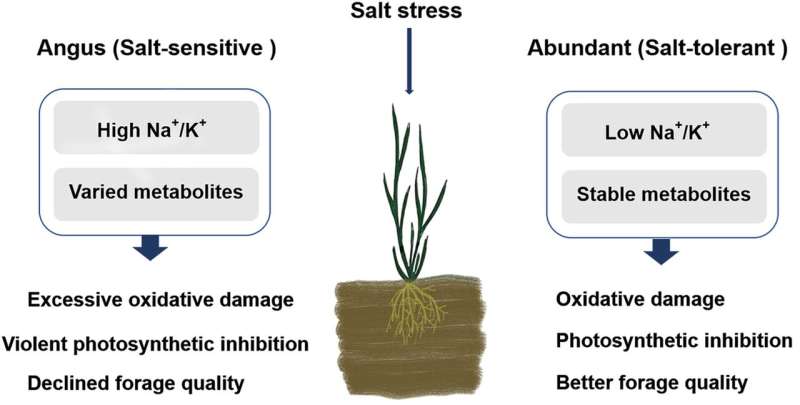Speculated model for Italian ryegras grown with 300 mM salt stress. Credit: FENG Qijia
Italian ryegrass (Lolium multiflorum) is a widely cultivated forage with excellent quality, high yield, good palatability and rich nutritional value. However, its growth is inhibited by salt tress, which is a major growth limiting factor.
In order to elucidate the salt tolerance mechanism of two Italian ryegrass cultivars, Feng Qijia, co-advised by Prof. Chen Liang and assistant Prof. Xie Yan from the Wuhan Botanical Garden of the Chinese Academy of Sciences (CAS) investigated the possible salinity tolerance mechanisms between the salt-tolerant/-sensitive Italian ryegrass cultivars, Abundant and Angus, via the physiological traits and the metabolomics.
Salt stress decreased the shoot growth rate and relative water content in both cultivars, to a larger extent in the salt-sensitive Angus than salt-tolerant Abundant cultivar. The photosynthetic efficiency responses to salt stress confirmed that the Abundant cultivar exhibited better salt tolerance than Angus. The Na/K, Na/Mg and Na/Ca ratios in the leaves and roots increased significantly in both cultivars under salt treatment, with higher ratios in salt-sensitive Angus than in salt-tolerant Abundant.
The first line of defense is the absorption of Na by roots and the ability to transport it upward. Salt-tolerant Abundant absorbed less, thus reducing osmotic and toxic effects. When exposed to salt conditions, the salt-sensitive Angus had higher level of metabolites and more uniquely up-regulated metabolites, which may confer Abundant to a better growth than Angus.
The Abundant cultivar has got better growth than Angus cultivar, and its high tolerance of salt partly prevents the plant from ionic homeostasis disruption.
The results have been published in Physiologia Plantarum entitled "Comparative physiological and metabolic analyses of two Italian ryegrass (Lolium multiflorum) cultivars with contrasting salinity tolerance."
More information: Qijia Feng et al. Comparative physiological and metabolic analyzes of two Italian ryegrass ( Lolium multiflorum ) cultivars with contrasting salinity tolerance, Physiologia Plantarum (2021). DOI: 10.1111/ppl.13374
Provided by Chinese Academy of Sciences






















